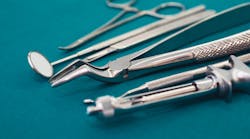Paper up or paper down? Clarifying instrument reprocessing standards
We recently hired a new dental assistant who is questioning how we sterilize instruments. We had a team meeting about it, and no one agreed on how we should do it. We can’t even agree on whether our pouches should go in the autoclave paper up or paper down. Please clarify what is right.
Oh, the great debate—paper up or paper down? An excellent resource to help calibrate your standard operating procedures (SOP) is the Centers for Disease Control (CDC) Summary of Infection Prevention Practices in Dental Settings Basic Expectations for Safe Care.1 This document provides an easy checklist to ensure you follow the basic infection prevention recommendations. Equally important are the instructions for use (IFU) of all your equipment, instruments, and devices.
When sterilizing patient care items and devices, you need to have everyone on the same page. And if you’re like most offices, reprocessing instruments is a team effort. I love that you had a team meeting to try to figure out what to do. Now, let’s get the facts so you can create some evidence-based SOPs.
Classification
You first need to understand what items require sterilization. Patient care items are categorized depending on their potential risk for disease transmission. Critical items penetrate soft tissue (e.g. scalers), semicritical touch mucous membranes (e.g., hygiene handpieces), and noncritical only contact skin (eg, blood pressure cuff). Both critical and semicritical items should be heat sterilized. If they are not heat tolerant, such x-ray sensors, they should be covered with an FDA-approved barrier and disinfected after removal according to the instructions for use. And it should go without saying that all single-use items are just that, single-use and put in the trash after use.
Clean and decontaminate
Once you figure out what needs to be reprocessed, don the proper PPE. This includes puncture and chemical-resistant utility gloves, eye protection, and a long-sleeved fluid-resistant gown to protect you from splashes and sticks.
All the bio-burden must be removed from the instruments before sterilization. If the instruments can’t be cleaned immediately, consider a pre-enzymatic spray or soak to prevent debris from sticking to the instruments. Then, use an FDA-approved ultrasonic cleaner, instrument washer, or washer disinfector to remove debris and decrease opportunities for an instrument stick. If debris remains, use proper PPE and scrub with a long-handled brush. Rinse the instruments and allow them to dry before packaging.
Package properly
Before packaging, ensure instruments are dry. Water droplets impede sterilization and can compromise packaging. Open up all hinged instruments and be sure not to overstuff bags.
Unless an instrument is going to be used immediately, all instruments must be packaged so they remain sterile. Most bags come with both an internal and external indicator. If the indicator isn’t visible from the outside, such as when using sterilization wrap, place a chemical indicator inside the cassette and use tape with an indicator on the outside.
Packages should be labeled on the folds of the bags or the sterilization tape so as not to affect the package. Label them with the sterilizer used (if more than one), cycle load number, and date. This way, you can recall the affected instruments if there is a sterilization failure.
Paper up or paper down?
The paper up/paper down debate is settled here: Pouch orientation can be different in different sterilizers. Paper up, paper down, and even pouches stacked sideways are all options you may find in your IFUs, so you have to read them. When loading the sterilizer, be sure not to overlap the packages to leave room for the air/steam to penetrate all the packaging. When the load is finished, let the instruments cool and dry before unloading—no playing hot potato with packages. Wet packs are not considered sterile because excessive moisture can act as a pathway for microorganisms and should be repackaged and resterilized.
Biological indicators (e.g, spore tests) must be used at least weekly to ensure the sterilizer works properly. Those can be done in-office or mailed in. Be sure to keep records that comply with your state and local regulations.
Storage
Prior to storing sterilized instruments, check to see if the external and internal (if visible) indicators have changed color and that the packages haven’t been compromised with instruments poking through. Store in closed cabinets or drawers to prevent contamination.
Routine maintenance
Last, pull back out those IFUs for your sterilizer and read the daily, weekly, and monthly maintenance. Performing the recommended maintenance will decrease the chances of having a sterilizer emergency and elongate the life of your machine.
Good luck at your next team meeting, and I hope you all get on the same page when it comes to instrument sterilization.
Editor's note: This article appeared in the March 2024 print edition of RDH magazine. Dental hygienists in North America are eligible for a complimentary subscription. Sign up here.
Reference
- Centers for Disease Control and Prevention. Summary of Infection Prevention Practices in Dental Settings: Basic Expectations for Safe Care. October 2016. https://www.cdc.gov/oralhealth/infectioncontrol/pdf/safe-care2.pdf
About the Author

Amanda Hill, BSDH, RDH, CDIPC
Amanda Hill, BSDH, RDH, CDIPC, is an enthusiastic speaker, innovative consultant, and award-winning author who brings more than 25 years of clinical dental hygiene and education to dentistry. Recipient of ADS’s Emerging Infection Control Leader award and an active participant with the advisory board for RDH magazine, DentistryIQ, and ADS’s Infection Control in Practice Editorial Review Board and membership committee, Amanda (also known as the Waterline Warrior) strives to make topics in dentistry accurate, accessible, and fun. She can be reached at [email protected].


